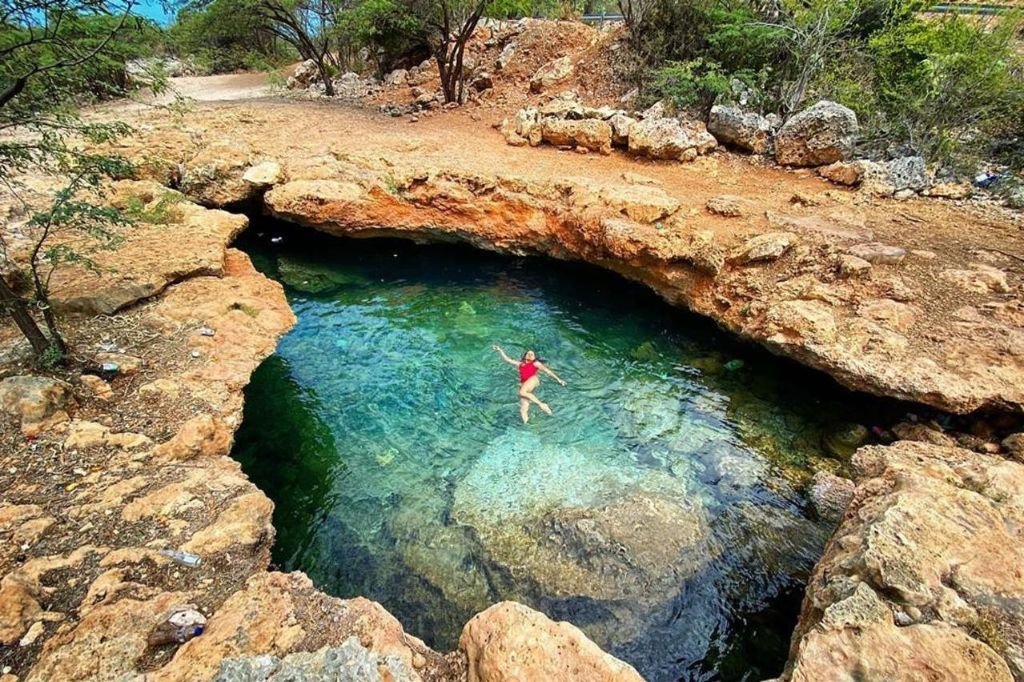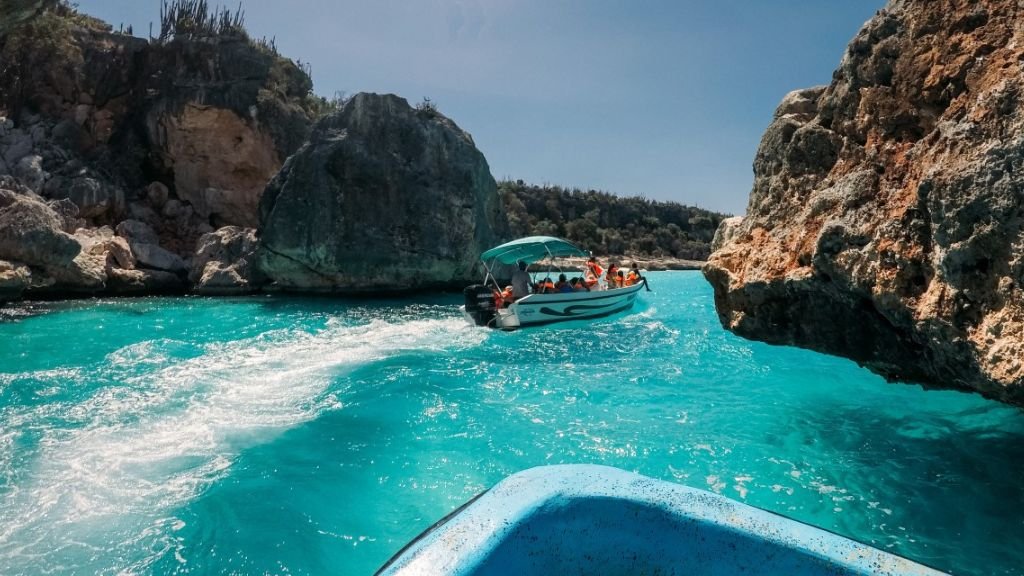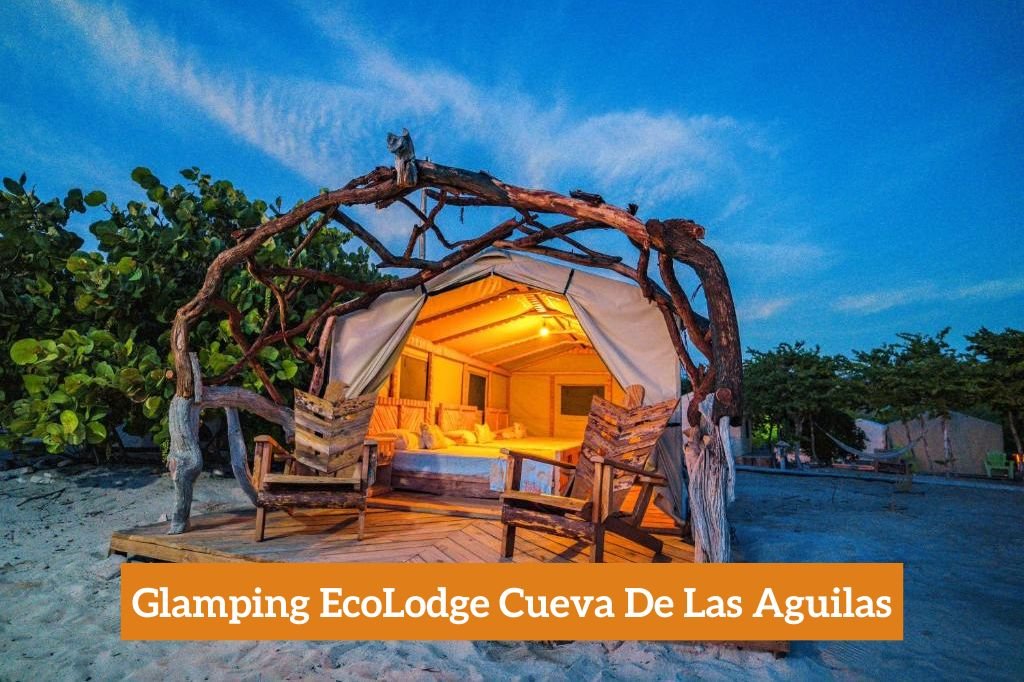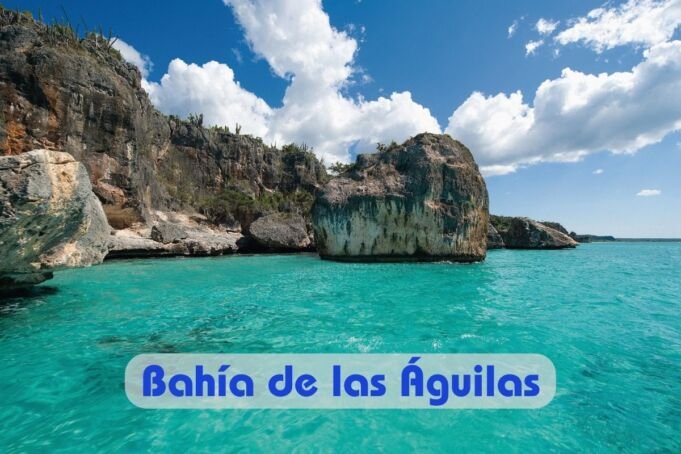Bahía de las Águilas stands out as a hidden gem within the Caribbean, acclaimed as one of the most magnificent beaches in the Dominican Republic. It outshines well-known destinations like Punta Cana and Samaná, with many locals considering it the country’s most exquisite beach.
So, what makes Bahía de las Águilas so special? How does one travel there from Punta Cana or Santo Domingo? And is it worth the journey to the Dominican Republic’s distant Southwest? The upcoming article delves into these questions, offering insights into this remarkable beach. Additionally, it will highlight exciting developments in 2024 for those planning to visit Bahía de las Águilas from Punta Cana and Santo Domingo.
Location and Historical Background of Bahia de las Aguilas
Situated in the southwestern part of the Dominican Republic, Bahia de las Aguilas is part of the Jaragua National Park. This location is significant not just for its stunning vistas but also for its ecological importance. The bay is nestled in a remote area, making it one of the least disturbed coastal environments in the Caribbean. Its geographical positioning along the Caribbean Sea contributes to its unique marine and coastal ecosystems.
Historically, Bahia de las Águilas has been relatively isolated, which has helped preserve its pristine condition. The area around the bay holds a rich cultural heritage, reflecting a blend of indigenous Taino influences and Spanish colonial history. This region played a crucial role in the early history of the Dominican Republic, and today, it stands as a testament to the diverse cultural narratives that have shaped the nation.
Natural Beauty and Landscape
Description of the Beaches and Crystal-Clear Waters
The beaches of Bahia de las Aguilas are often described as some of the most beautiful in the world. Stretching over 8 kilometers, these beaches boast powdery white sands and crystal-clear waters with hues ranging from turquoise to deep blue. The clarity of the water enhances visibility, making it an ideal spot for snorkeling and underwater exploration.
The Unique Flora and Fauna of the Region
The area around Bahia de las Aguilas is a hotspot of biodiversity. It is home to a variety of unique flora, including species of cacti and baobab trees, which are rare in the Caribbean. The region’s fauna is equally diverse, with a range of bird species, including the bay’s namesake eagles, as well as reptiles and marine life that thrive in this unspoiled habitat.
Geological Features and Landscape Diversity
The geological landscape of Bahia de las Aguilas is as diverse as its biological one. The coastline is characterized by dramatic cliffs and rocky outcrops, while the hinterlands feature a mix of dry forests and scrublands. This variety in landscapes not only contributes to the scenic beauty of the area but also supports a wide range of ecosystems.
Read More: Mushroom House
Cultural and Historical Significance of Bahia de las Águilas
The area around Bahia de las Aguilas is rich in history. Nearby, the Jaragua National Park contains archaeological sites that offer insights into the pre-Columbian Taino culture. There are also remnants of the early colonial period, including historical ruins and artifacts that speak to the area’s past.
The cultural heritage of the region is deeply influenced by both the indigenous Taino people and Spanish colonial history. This blend is reflected in local traditions, arts, and festivals. Visitors can experience this rich cultural tapestry through interactions with local communities, where traditional crafts and storytelling are still prevalent.
The indigenous and colonial histories have left a lasting impact on Bahia de las Aguilas. The Taino influence is evident in the archaeological sites and the continued presence of their art and traditions in local communities. The Spanish colonial period introduced new architectural styles and cultural practices, many of which have been integrated into the local way of life.
What are the Attractions Near Bahia de las Aguilas?
Cabo Rojo Beach
Situated in Pedernales province on the southwest coast of the Dominican Republic, Cabo Rojo Beach is celebrated for its stunning white sands. The beach’s name, translating to ‘Red Cape,’ is derived from the reddish hue of the dirt roads, a result of limestone and bauxite in the area. It ranks among the region’s most visited beaches, mesmerizing tourists with its breathtaking coastal views and turquoise waters. These waters are a sanctuary for well-preserved coral reefs, providing a habitat for West Indian manatees and hawksbill turtles.
Pozos Ecologicos de Romeo Francés

The Pozos Ecologicos de Romeo Francés are remarkable large freshwater pools located along the Pedernales-Barahona road. These three ecological wells are nestled within rock formations and offer crystal-clear waters ideal for swimming. Visitors can enjoy a distinctive experience surrounded by small, vibrant fish that add to the pools’ blue hues. These natural wells offer a chance to immerse oneself in the unspoiled beauty of the region.
Beata Island
Positioned in the Caribbean Sea, about 7 kilometers southwest of Cape Beata, is Beata Island. Its triangular shape covers an area of just under 27 square kilometers. Over time, the island has emerged as a notable tourist destination, despite its limited development. It offers unique attractions, including a species of giant snail and a diverse range of sea turtles, lobsters, and crabs, making it an intriguing spot for visitors.
Read Also: Oregon Road Trip
Navigating to Bahia de las Aguilas by Car
Bahía de las Águilas, situated in the Cabo Rojo region, can be reached from La Cueva de las Pescadores after a drive of over 3 hours from Barahona.
Journey from Barahona to Cabo Rojo’s Entrance:
Starting from Barahona, the 110km drive (approximately 2.25 hours) to Cabo Rojo’s entrance is scenically rich, featuring coastal views with the ocean on one side and mountains on the other. This route offers a glimpse into local life as it passes through small towns. Drivers should remain vigilant due to sharp bends, speed bumps, and the presence of buses, trucks, and motorcycles.
From Cabo Rojo’s Entrance to La Cueva:
The trip from the main road, Route 44, to La Cueva de los Pescadores spans about 14km (over 30 minutes). Initially paved, the road eventually turns into a gravel path with several dips. It is navigable by any vehicle, though slow speeds are necessary. The route runs through a seemingly barren landscape dotted with cacti and other dry vegetation. Despite possibly feeling lost, following the signs will lead you to the sight of water, indicating proximity to your destination. You’ll then encounter two glamping sites and boats on the beach, signaling your arrival.
La Cueva to Bahia de las Águilas:
From La Cueva de las Pescadores, there are three ways to reach Bahia de las Aguilas: by boat, a 5km hike, or a drive over the hill. Although previously a 4×4-exclusive route, recent improvements have made the drive over the hill feasible for all vehicles, albeit with caution. While the hilltop view is spectacular, the most relaxing and recommended mode of reaching Bahia de las Aguilas is by taking a boat from Playa de La Cueva.
Boat Journey to Bahia de las Aguilas

Prepare for a breezy adventure! The boat trip from La Cueva de las Pescadores, also known as the fisherman’s cave, to Bahia de las Aguilas is an exhilarating ride past stunning rock formations. It’s a unique experience to be dropped off at a pristine beach by boat, with a guaranteed pickup at a pre-arranged time.
Glamping EcoLodge Cueva de las Aguilas Services
At Glamping EcoLodge Cueva de las Aguilas, which offers both glamping accommodations and a restaurant, boat transport to Bahia de las Aguilas is available. Boats operate from 8:30 am to 5:30 pm, including life jackets for safety. The boat trip lasts about 15-20 minutes, costing around $3,175 DOP (approximately $60 USD) for a group of up to five people, round-trip.
Scenic Boat Route and Beach Arrival
During the trip, captains often choose a picturesque route, gliding past enormous boulders in the water and pointing out hidden gems along the way. You’ll be left at a secluded part of Bahia de las Aguilas beach, with an agreed-upon time for the captain to return for pickup.
Also Read: Chocolate Hills
Reserving Your Boat Trip
Boat reservations can be made online, with payment at the front desk of Glamping EcoLodge Cueva de las Aguilas. They offer all-inclusive packages that may include amenities like tables, chairs, umbrellas, snorkeling gear, and food. For more detailed information and additional queries, refer to their website or contact them directly.
Lodging Choices Near Bahía de las Águilas
At Bahía de las Águilas itself, you won’t find any accommodations due to the lack of infrastructure on this unspoiled beach.
However, there are a couple of nearby alternatives, each offering a different experience.
Glamping Near Bahía de las Águilas in Cabo Rojo
For those wanting to stay close to Bahía de las Águilas, consider the adjacent bay in Cabo Rojo, often referred to as Cueva de las Águilas. While the beach here might not rival the beauty of Bahía de las Águilas (yet still stunning, as seen in the photo), the ocean is equally turquoise and inviting. This location is also where most boat trips to Bahía de las Águilas commence.
The available lodging options here are more of a glamping experience, with luxurious tents set up right on the beach. Although the beach doesn’t quite match the perfection of Eagles Bay, the clear, picturesque waters are very much alike.
Glamping EcoLodge Cueva De Las Aguilas

This option tends to be more budget-friendly among the two glamping sites near Bahía de las Águilas. It stands out for its cost-effective boat trips and superior organization. Though the beach may be slightly less appealing and somewhat grey, the beautiful ocean views compensate for it.
Eco del Mar
Eco del Mar offers a more upscale glamping experience, albeit with a bit of an unstructured approach in management. Budget tents might not always offer the best value, but their higher-end casitas, deluxe suites, or junior suites promise a remarkable stay. Additionally, the beach and bar at Eco del Mar are notably more attractive than at the Glamping EcoLodge Cueva De Las Águilas.
Casa Grande Bahia Ecolodge
As the only non-glamping option besides the others, Casa Grande Bahia Ecolodge at Cueva de las Águilas is simple and straightforward, ideal for a no-frills stay. Perfect for budget-conscious travelers or those on a quick visit, it offers basic accommodation without any luxury.
Hotels in Pedernales
For those who prefer more conventional hotels over glamping, Pedernales provides various local lodging options. This bustling Dominican city near the Haitian border is filled with shops and simple eateries. While it lacks luxury, Pedernales is advantageous for its infrastructure and affordability, especially appealing if you don’t mind the extra 45-minute drive to Cueva de las Águilas. Accommodations here are generally more budget-friendly than those closer to Eagles Bay.
Know More: Antelope Canyon in February
Biodiversity and Conservation
The wildlife in Bahia de las Aguilas is notable for its variety and rarity. The bay’s marine environment is rich in coral reefs, home to an array of colorful fish and marine species. On land, the area is inhabited by various bird species, including the magnificent frigatebird and the endemic Hispaniolan lizard-cuckoo, among others.
Bahia de las Aguilas is a crucial biodiversity hotspot in the Caribbean. The unique combination of terrestrial and marine ecosystems supports a wide array of species, many of which are endemic or endangered. This biodiversity is not only important for ecological balance but also contributes to the global significance of the area in terms of wildlife conservation.
Recognizing its ecological importance, Bahia de las Aguilas and the surrounding Jaragua National Park are protected under Dominican law. Efforts are continuously made to conserve this natural treasure. These include regulating tourism, conducting scientific research to monitor and preserve the ecosystems, and community-based initiatives aimed at promoting sustainable practices. These conservation measures ensure that Bahia de las Aguilas remains a sanctuary for its diverse wildlife and a pristine natural wonder for generations to come.
Travel Advice for Bahia de las Aguilas
- Timing Your Visit: It’s best to skip the summer months from July to September, as the heat can become intense, even during nighttime. Opt for a mid-week visit, whether you’re camping or just taking a day trip to the beach, as this is when it’s quieter and more affordable compared to the crowded and costlier weekends. Definitely avoid Dominican Republic public holidays due to extreme crowding. Check out the 2024 holiday infographic for the Dominican Republic for planning.
- Mosquito Precautions: Mosquitoes and no-see-ums, particularly active in the evenings and early mornings, can be relentless at the campsites. Make sure to use ample mosquito repellent, and consider fumigating your tent to ward off other insects.
- Food and Drink Supplies: While there are restaurants nearby, it’s wise to bring your own snacks and beverages. Pack your favorite snacks like chips or trail mix, and perhaps a bottle of wine to savor by a bonfire.
- Stay Hydrated: The southern sun can be deceptively strong, leading to dehydration. Regularly drink water, preferably with added electrolytes, to stay hydrated.
- Sun Protection: Regularly apply reef-safe sunscreen and wear a hat for sun protection, but be cautious when on boat rides to Bahia as hats can easily blow away.
- Appropriate Footwear: Since Bahia de las Aguilas beach lacks restroom facilities, camping bathroom rules apply. When stepping into the trees, wear sturdy, hard-soled shoes to protect against cacti and other sharp plants in the sand.
Is Bahia de las Aguilas Worth the Effort?
Absolutely! Making the trip to Bahia de las Aguilas is more rewarding than ever before. The Dominican Republic government has recently greenlighted an ambitious project to transform Cabo Rojo into a new hotspot akin to Punta Cana. Plans are in motion for about 12 major hotels to commence construction in the area. With shopping centers, an international airport, and all-inclusive resorts on the horizon, the Pedernales region is set to become a top destination for thousands of tourists. This development is sure to alter the ambiance and experience for adventure travelers like yourself. Discover more about this project, its potential impacts on your travel experience, and the future of this region.
The Jaragua National Park and Bahia de las Aguilas are indeed precious gems. These are places of awe-inspiring beauty that deserve to be cherished and preserved, ensuring their splendor can be appreciated for many years to come. As a visitor, it’s vital to be conscientious. Always clean up after yourself, disposing of trash in designated bins. Show respect for the local wildlife you might encounter, such as starfish, sea turtles, and coral reefs.
If you’re contemplating a journey to the deep south of the Dominican Republic, Bahia de las Aguilas is definitely worth the trek. It’s an opportunity to turn your screensaver fantasies into reality and experience a breathtaking beach getaway like no other!
You Can Read: Best Places to Live in Florida
Conclusion
Bahia de las Aguilas is not just a stunning destination; it’s a crucial ecological haven with rich cultural significance. Its unspoiled beaches, diverse wildlife, and historical importance make it a unique and valuable part of the Dominican Republic and the wider Caribbean region.
The preservation of Bahia de las Aguilas is a responsibility that falls not only on local authorities but also on every visitor. Sustainable tourism practices, respect for local customs and traditions, and active participation in conservation efforts are essential. By appreciating and safeguarding its natural beauty and cultural heritage, visitors can ensure that Bahia de las Aguilas remains a pristine and vibrant destination for future generations. This bay is a reminder of the delicate balance between enjoying our planet’s wonders and preserving them for the future, a balance that requires ongoing commitment and care.















